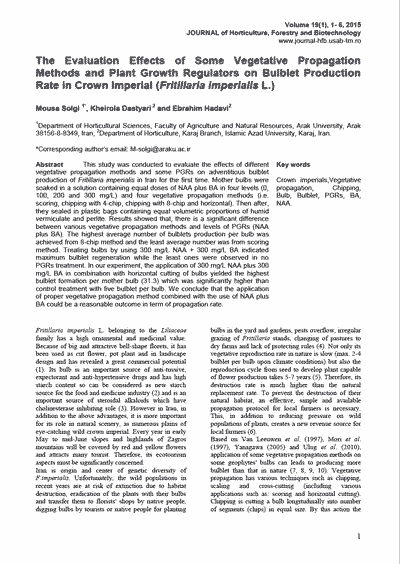NEWS 2015
The Evaluation Effects of Some Vegetative Propagation Methods and Plant Growth Regulators on Bulblet Production Rate in Crown Imperial (Fritillaria imperialis L.)
Mousa SOLGI¹, Kheirola DASTYARI²,Ebrahim HADAVI²
Journal of Horticulture, Forestry and Biotechnology 19(1): 1- 6 (2015)
http://www.journal-hfb.usab-tm.ro
¹Department of Horticultural Sciences, Faculty of Agriculture and Natural Resources, Arak University, Arak 38156-8-8349, Iran
²Department of Horticulture, Karaj Branch, Islamic Azad University, Karaj, Iran
Abstract
This study was conducted to evaluate the effects of different vegetative propagation methods and some PGRs on adventitious bulblet production of Fritillaria imperialis in Iran for the first time. Mother bulbs were soaked in a solution containing equal doses of NAA plus BA in four levels (0, 100, 200 and 300 mg/L) and four vegetative propagation methods (i.e. scoring, chipping with 4-chip, chipping with 8-chip and horizontal). Then after, they sealed in plastic bags containing equal volumetric proportions of humid vermiculate and perlite. Results showed that, there is a significant difference between various vegetative propagation methods and levels of PGRs (NAA plus BA). The highest average number of bulblets production per bulb was achieved from 8-chip method and the least average number was from scoring method. Treating bulbs by using 300 mg/L NAA + 300 mg/L BA indicated maximum bulblet regeneration while the least ones were observed in no PGRs treatment. In our experiment, the application of 300 mg/L NAA plus 300 mg/L BA in combination with horizontal cutting of bulbs yielded the highest bulblet formation per mother bulb (31.3) which was significantly higher than control treatment with five bulblet per bulb. We conclude that the application of proper vegetative propagation method combined with the use of NAA plus BA could be a reasonable outcome in term of propagation rate.

